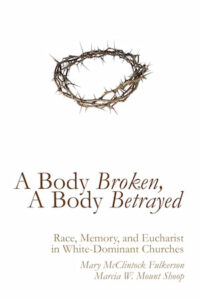Review of A Body Broken, A Body Betrayed: Race, Memory, and Eucharist in White-Dominant Churches
Posted on December 23, 2015 by PLT Staff
 In A Body Broken, A Body Betrayed, theologians and Presbyterian ministers Mary McClintock Fulkerson and Marcia Mount Shoop focus on the ways a professed “colorblindness” among many white-dominated churches actually embodies unconscious racialized assumptions and biases that harm people of color. Colorblindness creates an amnesia around racialized systems, histories and bodies that obscures the social privilege of white Christians and congregations. That is, the memories and stories we tell ourselves about who we are and from where we’ve come conspire to shape and grow the blind spots of institutions like the church.
In A Body Broken, A Body Betrayed, theologians and Presbyterian ministers Mary McClintock Fulkerson and Marcia Mount Shoop focus on the ways a professed “colorblindness” among many white-dominated churches actually embodies unconscious racialized assumptions and biases that harm people of color. Colorblindness creates an amnesia around racialized systems, histories and bodies that obscures the social privilege of white Christians and congregations. That is, the memories and stories we tell ourselves about who we are and from where we’ve come conspire to shape and grow the blind spots of institutions like the church.
With this background, the authors address the “colorblindness” embedded within the Eucharistic practice in many white-dominated churches. For McClintock Fulkerson and Mount Shoop, the Eucharist often becomes a practice disconnected from the everyday realities of the lives of practitioners, and in this abstract and ritualized form could actually foster racial solidarity among whites. Instead of opening congregations up to the ‘other,’ the Eucharist often “creates sacrament out of sameness” and insulates churches from the unacknowledged wounds of our colorblind memories. It runs the risk of functioning as an appreciate remembrance of a past act rather than a transformative practice with consequences for how we live in the present.
For Eucharist to offer a transformative, liberative act of remembering that responds to God and one another in the particular situation in which we find one another, it must attend to the contextual realities of those gathered around the table and those who are absent. In Eucharist we not only remember God’s fidelity toward us, but also the “tragic and violent marks of betrayal and ruptured relationship.” For white-dominated churches, according to the authors, this is especially important in remembering the wound of colorblindness.
The authors propose viewing the Eucharist with a “flexible memory” that listens to dissonant stories. This requires the telling of contemporary stories of brokenness and betrayal as part of the liturgy, which may open us up to new ways of seeing our own past and present. In this way the church community can cultivate the skills to notice and name habits and systems that often go unacknowledged and inflict racialized harm. Eucharist, practiced in this way, can disrupt our own self-protective assumptions and attend to God’s presence with those who suffer in the world. It may even change the way we read our own history and understand the abuses we have perpetuated while calling ourselves the Body of Christ. A Body Broken concludes with three vignettes of Eucharistic flexibility, examples of ways the Eucharist has been opened to include others’ stories and contexts. Each of these practices opened congregations to a liberative form of remembering and made Eucharist a template for healing around the wounds of race.
- Paper Information
- Author: Kristopher Norris
- Creation Date: December 2015
- PDF: View / Download File »
